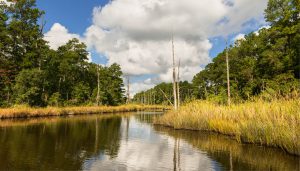North Carolina welcomes us with its more or less Mediterranean climate, but the air feels more humid and it is rainier and wetter all year round. Traveling inland from the wide coastal plain, the land becomes steeper as we ascend to the Piedmont plateau and up to the Blue Ridge Mountains in the larger Appalachian range. The pine forests of the coastal plain are unrepresented in Group 20, but we have an interesting variety of little known American Quercus species: Shumard’s oak, Black oak, Post oak, Shingle oak and Virginia oak. Adorning the front of the group are Amber trees that light up with rich colors during the autumn months. A plantation of young Black birches has been lost in the back of the group, and there remain only a few lonely specimens. The vacant space in the group was an opening in the oak forest of former times, and the resulting corridor offers a new vista from above. This corridor is currently being planted with smaller tree species and shrubs: Eastern redbud, Red mulberry, Tupelo, serviceberry, hawthorn, chokeberry, etc. These plantations are currently enclosed by a fence to prevent damage by row deer.


